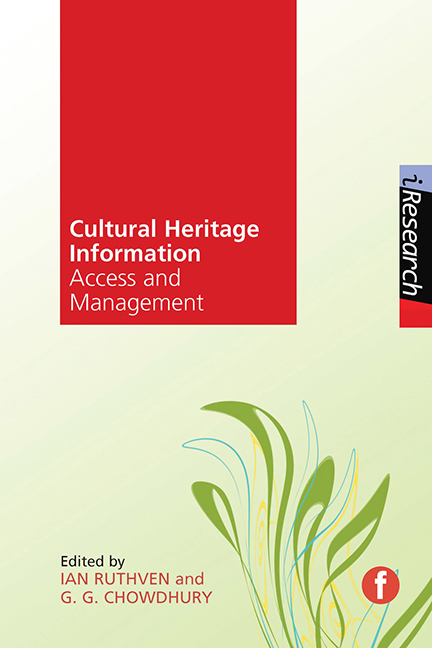Book contents
- Frontmatter
- Contents
- List of figures and tables
- Contributors
- Preface
- 1 Managing digital cultural heritage information
- 2 Digital humanities and digital cultural heritage (alt-history and future directions)
- 3 Management of cultural heritage information: policies and practices
- 4 Cultural heritage information: artefacts and digitization technologies
- 5 Metadata in cultural contexts – from manga to digital archives in a linked open data environment
- 6 Managing cultural heritage: information systems architecture
- 7 Cultural heritage information: users and usability
- 8 A framework for classifying and comparing interactions in culturalheritage information systems
- 9 Semantic access and exploration in cultural heritage digital libraries
- 10 Supporting exploration and use of digital cultural heritage materials: the PATHS perspective
- 11 Cultural heritage information services: sustainability issues
- Index
6 - Managing cultural heritage: information systems architecture
Published online by Cambridge University Press: 10 September 2022
- Frontmatter
- Contents
- List of figures and tables
- Contributors
- Preface
- 1 Managing digital cultural heritage information
- 2 Digital humanities and digital cultural heritage (alt-history and future directions)
- 3 Management of cultural heritage information: policies and practices
- 4 Cultural heritage information: artefacts and digitization technologies
- 5 Metadata in cultural contexts – from manga to digital archives in a linked open data environment
- 6 Managing cultural heritage: information systems architecture
- 7 Cultural heritage information: users and usability
- 8 A framework for classifying and comparing interactions in culturalheritage information systems
- 9 Semantic access and exploration in cultural heritage digital libraries
- 10 Supporting exploration and use of digital cultural heritage materials: the PATHS perspective
- 11 Cultural heritage information services: sustainability issues
- Index
Summary
Introduction
This chapter is about the architecture of systems that store, preserve and provide access to digital cultural heritage objects. It presents some major design considerations for implementing cultural heritage system architectures and some existing architectural patterns currently in use. Then, a simpler architectural design is proposed; this new architecture could potentially have a positive impact on digital preservation.
Digital library systems (DLSs) are specialized information systems designed to store, manage and preserve digital content over long periods of time. With the increase in the number of historical artefacts being digitized, the cultural heritage space is one of many application domains where DLSs are currently used, in an effort to foster easy access to this information and additionally preserve the digital content for future use.
While the motivation for using cultural heritage DLSs (hereafter also referred to as cultural heritage systems) is common across systems, the architectural choices made when designing cultural heritage tools and services varies. The variation in the architectural designs are, in part, influenced by the type – video, audio, digital scans, multi-dimensional models, etc. – of cultural heritage artefacts that will be subsequently digitally preserved and how the digital objects will be subsequently accessed. The next section highlights these requirements further.
The high-level design of these systems takes the form of an architectural framework composed of three main components: a repository layer that stores and manages the digital objects; a service layer with necessary services required to access and manipulate the digital objects; and a user interface layer used by end-users to access the digital objects (Arms, 2000). This is illustrated in Figure 6.1, with specific examples of content and services indicated at each layer.
The remainder of this chapter is organized as follows: ‘Resource requirements of cultural heritage systems’ describes the major resource requirements for cultural heritage systems; ‘Major design constraints and patterns’ describes some design constraints and architectural patterns associated with cultural heritage systems; and, finally, ‘Designing for preservation: simplicity’ presents a proposed architectural design aimed at ensuring that the resulting tools and services simplify the overall preservation lifecycle.
Resource requirements of cultural heritage systems
The general technological requirements for designing and implementing cultural heritage systems were summarized in the RLG/OCLC report Trusted Digital Repository: Attributes and Responsibilities (RLG/OCLC Working Group on Digital Archive Attributes, 2002).
- Type
- Chapter
- Information
- Cultural Heritage InformationAccess and Management, pp. 113 - 134Publisher: FacetPrint publication year: 2015
- 1
- Cited by



